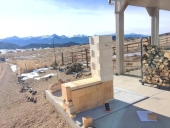Today I had the chance to work on a lighting / outlet circuit in our home. I’m going to use this to attempt the following 2 BB’s for 2.5 points for the Straw Badge:
Add an outlet circuit and circuit breaker – 1 point
– At least 4 outlets or one 20A dedicated outlet (fridge, disposal, etc)
– If GFCI or AFCI protected, add ½ point
Install 20 feet of wire in an unfinished space – 1 point
Here’s a shot after about 1/2 of the insulation is in this bedroom wall. You can see the two light sconce boxes above joined by a run of 12/2 and the closest one connected to the switch box, red arrow.

This circuit has 1 light switch, two lights, and four outlets, 2 on each side of the wall. Here is a shot of the boxes and how wiring is joining them.

I waited until drywall was up to begin installing outlets, this is one outlet on the bedroom side which supplies power from the circuit breaker to the light switch.

I used the wire strippers to strip the wire back 5/8″ or so to make my loops. All three ground wires were twisted together then wire nutted.

Even though my receptacles can take wire straight in I choose to loop and screw. Here I’m making the eyelet loops.

Neutral and ground wires all attached to my receptacle. Red is to the light switch and green comes from the breaker box. Note loops are all oriented to be pulled shut as the screws are tightened.

Outlet installed and ready for testing.

The yellow wire is a 22′ run from the breaker box (distance) running along the floor joists then up into the wall (behind). I will be installing protective boards above the wire so if anyone decides to hang stuff from the wires they won’t be damaged.

Wiring run under the floor joists are stapled at 4′ intervals and 8″ from boxes.

We have a box that uses QO breakers, I try to keep a unit or two on hand, just in case…

This is a very old (circa ’67) breaker box and will be updated to a 200 amp unit when our solar array is installed. The yellow arrow is our new ground, red arrow is new neutral, and red oval is the new 20 amp arc fault breaker.

Clearing out a knockout in the breaker panel for the new 20 Amp breaker.

Outlet and wall sconce circuit finished as noted by lit light and correct two lights on the circuit tester.


















































